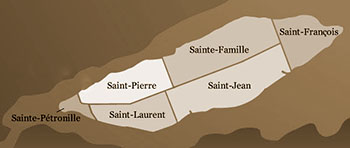 |
|||||||||
|
|||||||||
Nicolas Audet dit Lapointe and Madeleine Després |
|||||||||
|
|||||||||
|
|||||||||
|
Nicolas Audet was born about 1641. He was the son of Innocent Audet and Vincente Riene (Roy), of Saint-Pierre-de-Maillé which is a commune in the Vienne department in the Poitou-Charentes region in western France. He immigrated to Canada before 1664. He may have come with the French Army. In 1666, Nicolas worked on Bishop Laval's farm. Laval's farm was at Saint-Joachim which is a parish municipality in Quebec. It is part of the La Côte-de-Beaupré Regional County Municipality in the Capitale-Nationale region. It is located at the foot of Cape Tourmente. In 1668 he was a porter or caretaker at Bishop Laval's residence in Quebec. On June 22, 1667, the bishop granted Nicolas land on the Île d'Orléans, just opposite the Beaupré coast. He received three arpents (about an acre) on the Saint Lawrence River. He was required to pay rent every November 11th. On September 15, 1670, Nicolas married Madeleine Després. Madeleine was the daughter of François Després and Madeleine LeGrand. She was a fille du roi. Her passage was paid by the French goverment and and she received clothing and provisions, as well as, some practical items including a coiffe, a bonnet, a handkerchief, stockings, gloves, ribbon, shoelaces, thread, needles, pins, a comb, scissors, two knives and two livres in cash. The contract between Nicolas and Madeleine was arranged on August 30, 1670. Madeleine was sponsored by Dame Anne Gagnier, widow of Jean Bourdon and by Elizabeth Étienne. Her dowry was 200 livres plus 50 livres from the king because she was a fille du roi. The marriage was performed by Father Thomas Morel and the witnesses were Pierre Rondeau and Mathurin Dube. When they married, the government gave them an assortment of livestock and goods including chickens, pigs, an ox, a cow and two barrels of salted meat. They also received a yearly pension for having children. The first Nicolas Audet dit Lapointe was born and baptized on September 21, 1671. He died young. The second Nicolas Audet dit Lapointe was born on September 13, 1672. Pierre Audet dit Lapointe was born on June 22, 1674. Jean Baptiste Audet dit Lapointe was born, on November 17, 1675 and baptized on December 1. Marie Madeleine Audet dit Lapointe was born on September 18, 1677. In 1679, the parish of Ste-Famille was sub-divided and their farm became part of the village of St-Jean. Joseph Audet dit Lapointe was born on April 16, 1679. Joachim Audet dit Lapointe was born on October 27, 1680. Marie Audet dit Lapointe was born, on August 28, 1682. François Audet dit Lapointe was born, on April 10, 1684. Marguerite Audet dit Lapointe was born, on December 10, 1686. In August and September 1689, Nicolas, Sr. was hospitalized in Quebec. On July 9, 1696, Nicolas was granted three arpents of river frontage, some distance to the west of his own place. On August 2, 1698, he gave this land to his son Jean-Baptiste. Nicolas was buried, on December 10, 1700 in the cemetery at Saint-Jean. Madeleine passed on her inheritance to her son Joseph. On September 27, 1706, Etienne Jacob inventoried the estate. It included seventy-five arpents of usable land, a new house, measuring eighteen by twenty-four feet, a shed and a stable. Madeleine Després was buried beside Nicolas on December 19, 1712 .
|
|
|||||||
|
|||||||||
|
|||||||||
|
©Roberta Tuller 2025
|
|||||||||

